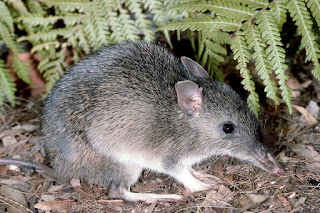
Long-nosed Bandicoot
Bandicoot is a small animal that belongs to the group of marsupials. It looks like a rat, but is actually more closely related to a rabbit. The bandicoot can be found in the rainforests, wet and dry forests, swamps and scrublands of Australia. Out of 21 species of bandicoot, seven are classified as critically endangered or already extinct. The number of bandicoots decreased dramatically as a result of climate change, habitat loss, and the introduction of new predator species.
Most species have two to six young at a time; gestation takes 12–15 days.
Bandicoot is a small marsupial. Males can be double of the size of the females. Bandicoots can reach 11 to 31 inches in length, and 0.4 to 3.5 pounds in weight.
Bandicoots are 30 to 80 cm (12 to 31 inches) long, including the 10- to 30-cm (4- to 12-inch) tail.
Bandicoots have long, pointed snout, large ears, short body and long tail. Their body is covered with fur that can be brown, black, golden, white or gray in color.
The body is stout and usually coarse haired, the muzzle tapered, and the hind limbs longer than the front.
Bandicoots have strong hind legs designed for jumping. Just like in kangaroos, second and third toe on each foot are merged together.
Their toes are reduced in number; two of the hind digits are united, with two claws emerging from the same toe (a trait known as syndactyly).
Bandicoots are nocturnal (active at night) animals. They will spend day hidden in dense vegetation, to avoid predators.
Their teeth are sharp and slender.
Due to small size, bandicoots are easy prey for dingoes, foxes, snakes and wildcats.
Their pouch opens rearward and encloses 6 to 10 teats.
Bandicoots are omnivores (they eat both plants and animals). They usually look for insects, small rodents, eggs, fruit, nuts, seed and berries.
Unlike other marsupials, bandicoots have a placenta.
When bandicoot detects underground prey, it digs a hole using its front paws and reaches its meal with long snout.
Bandicoots are terrestrial, largely nocturnal, solitary animals that dig funnel-like pits in their search for insect and plant food.
Bandicoots are vocal animals. They produce snuffing sound while they are looking for food and piglet-like grunting when the food is detected. Also, they produce high-pitched sounds when disturbed.
Farmers consider bandicoots as pests; some species are endangered, and nearly all have declined.
Bandicoots are territorial animals. They will aggressively protect their territory from all intruders that attempt to conquer it.
The long-nosed bandicoots are vaguely ratlike animals with long snouts.
Bandicoots are solitary animals that will gather only for mating. Both males and females reach sexual maturity at age of five months. Although female is able to have new litter every 7 to 8 weeks, only 2 to 3 litters will be produced each year.
The common long-nosed bandicoot is still tolerably common in lightly forested country in eastern Australia.
Just like in other marsupials, female is equipped with pouch. Bandicoots have the shortest period of pregnancy of all mammals that lasts only 12 days. Baby is very small and poorly developed at birth. After birth, it will crawls toward the pouch, where it will complete its development.
The eastern barred bandicoot is common in Tasmania, but it has been eliminated from the mainland, apparently by predation by red foxes and feral cats.
Baby spends 54 days in the pouch, attached to the teat which provides milk. Pouch usually holds between 3 and 6 babies at the same time.
The desert bandicoot, which has been considered extinct since 2016, lived in the central desert regions.
Unlike in other marsupials, pouch is open backward. This is special adaptation to the life style of bandicoots. Backward opening prevents dirt to enter the pouch when mother digs the ground while searching for food.
The three species of short-nosed bandicoots, Isoodon, are shorter-snouted, smaller-eared, and more heavily built than the long-nosed bandicoots and occasionally weigh up to 2.5 kg (5.5 pounds).
Young bandicoots are ready for independent life when they reach age of four months.
Rabbit-eared bandicoots, more usually known as bilbies, are species of Macrotis.
Bandicoots have short lifespan. If they manage to escape from the predators, bandicoots can survive up to three years.
The smaller lesser bilby (M. leucura) probably became extinct sometime between 1931 and 1960.








